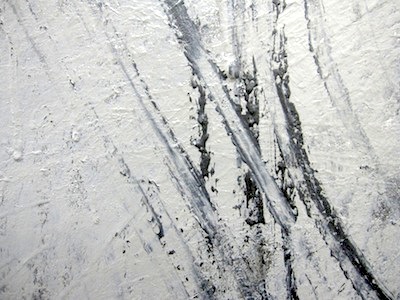Kabata’s painting is dominated by tracing lines that grope around and tumble as if searching for something (that perhaps will never be found) beyond the painting. It seems as if this scrabbling desire is unwrapped and being fixed on the surface of the painting as it is. The painting looks like a fetish of desire. Therefore, the painting no longer exists as representation, or it is an artwork of a mirror that never reflects the clear image. Since the clear image cannot be seen, the work can make the viewer uncomfortable and anxious. What could be the adherence to this desire to scrabble? How about considering it as a question of our consciousness of the world which would be physically grasped? Furthermore, I would like to consider of a possibility of the preexistence of the physical world before humans invented language as representation.
How large is the world that we actually live in? This kind of topic is being argued in psychology. Since we can go anywhere by either car or airplane, we tend to have an idea that our existing world extends without limit. The world in which we can exist is infinite. However if you transfer from Tokyo to New York, the place you actually live in each moment is only an extremely limited radius. As for the area, it is restricted to the radius that you can see, and as for the realization it is restricted to the reach that you can touch with the parts of your body; your hands or legs, which is very limited. Only the range within the five senses is the radius that we can live in, which is very limited. Then what extends this range is the world that only exists in the imagination. When you are in New York, Tokyo only exists in your imaginary world. Needless to say, what forms this imaginary world is language. In other words, the physical world is surrounded by the representative world; we build the world in which we live in by simultaneously holding those two worlds together. Although, before we master language, we must have fulfilled the world we live in with physical realization.
There is an invisible wall between the living physical world that our body and senses have full realization and an imaginary world that exists as a representation (nothing to do with body directly). It seems that Kabata’s artwork makes this invisible wall visible. Then the writhing desire that is trying to recover fulfillment with previous representational physical realization tumbles on the wall. As if it is trying to re-construct its own world with flesh and blood, beyond the language and representation. Therefore, Kabata’s artwork is painting beyond representation.
|
